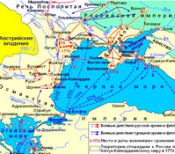
The Russo-Turkish War of 1768-1774 broke out
September 25 (October 6), 1768 began the Russo-Turkish war - one of the most significant wars between the Russian and Ottoman empires, as a result of which Kerch, Yenikale and Kinburn, the lands between the Dnieper and the Bug were attached to Russia and the Crimean Khanate gained independence under the protection of Russia.
The Russo-Turkish War of 1768-1774 resumed the struggle of Russia for an access to the Black Sea, against the aggression of the Ottoman Empire, which was anxious to expand its possessions in the Black Sea territories and in the Caucasus and capture Astrakhan. Turkey also was against consolidation of Russian influence in Poland, where in 1764 the throne was taken by the Russian protégé Stanislaus Augustus Poniatowski. The rapture of war became Russia’s declining of the Turkish ultimatum concerning the withdrawal of Russian troops from Poland, where from 1768 they were fighting against the Bar Confederation.
On September 25 (October 6) 1768 Turkey, having enlisted the support of France and Austria, launched military actions against Russia in Ukraine and in Caucasus.
Attempts of Turkish troops to break through to the heart of Russia were suppressed by the Russian Army under the command of P.A. Rumyantsev. The 1768-1769 campaign became a failure for the Turkish side, being not a big success of the Russian Army either.
The turning point happened in 1770 when military actions were mounted in the Lower Danube. Rumyantsev won a number of decisive victories at Larga and Kagul. Meanwhile the Russian squadron commanded by G.A. Spiridov for the first time in history managed to transfer from the Baltic Sea around Europe to the eastern part of the Mediterranean, having no bases en route and in condition of hostile attitude on the part of France. As a result it appeared in the rear of the Turkish Navy. Having successfully overcome the hardships of half a year navigation, Russian sailors crushed a defeat on the Turkish Navy in the Mediterranean Sea. At night June 25 – 26 1770 took place a decisive naval battle near the Chesma Bay of the Aegean Sea by the Small Asian coast. The Russian Navy (4 battleships, 2 frigates, 1bomb vessel and 4 fire-ships) having encountered the Turkish Navy (15 battleships and 70 other ships) in the Chios strait, made it retreat to the Chesma Bay. As a result of heavy artillery and fire-ships’ attacks the Turkish Navy was totally destroyed. In 1771 the Dardanelles were blocked, while the Turkish trading in the Mediterranean Sea was undermined.
In June 1771 the second army of General V.M. Dolgorukov seized the Perekop and then occupied the Crimea. In June and October the first army, acting on a broad front, despite the strength shortage, succeeded in preventing the enemy’s attempts to break through to the Danube’s left shore. On November 1 (12) 1772 Russia concluded a treaty with the Crimean Khan Sahib Giray, which stipulated that the Crimea became independent from Turkey being under the auspices of Russia.
In June 1773 chief forces of the Russian Army crossed the Danube. On June 9 (20) the 18 000 strong corps of the General A.V. Suvorov inflicted a defeat on the Turkish corps (40 000 soldiers) near Kozludzha. On the same day 15 000 strong Turkish unit suffered a defeat by the General I.P. Saltykov by Turtukan. Russian troops blocked the Shumla, Ruse (Rousse) and Silistra fortresses, whereas the vanguard under A.I. Zaborovsky crossed the Balkans.
Victories of the Russian Army made Turkey enter the peace negotiations, which finished with signing of the Treaty of Kuçuk Kainarji on July 10 (21) 1774. According to the peace treaty, the Crimean Khanate gained independence and went under the control of Russia. Apart from that, Russia inherited a considerable part of the northern coast of the Black Sea. The new border went through the Bug and Kuban. In the Crimea Russia received a town of Kerch and the Yeni-Kale fortress, on the Black Sea coast of the Northern Tavria — the Kinburn fortress. The Russian Navy got the right to freely cross the Bosporus and the Dardanelles.
Lit.: Петров А. Н. Война России с Турцией и Польскими конфедератами с 1769-1774 гг. СПб., 1866; То же [Электронный ресурс]. URL: http://runivers.ru/lib/detail.php?ID=432753; Веселаго Ф. Краткая история Русского Флота. М.; Л., 1939. Гл. 7. Русско-турецкая война 1768–1774 гг.; То же [Электронный ресурс]. URL: http://militera.lib.ru/h/veselago_ff/index.html; Сакович П. М. Действия Суворова в Турции в 1773 г. СПб., 1853; То же [Электронный ресурс]. URL: http://runivers.ru/lib/detail.php?ID=1026975; Тарле Е. В. Чесменский бой и первая русская экспедиция в Архипелаг // Академик Е. В. Тарле. Сочинения. Т. 10. С. 11—91; То же [Электронный ресурс]. URL: http://militera.lib.ru/h/tarle4/index.html.
Based on the Presidential Library’s materials:

